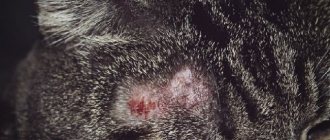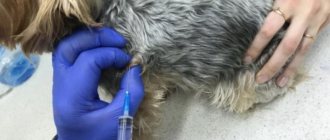Our pet fluffies, just like people, are susceptible to various diseases. Just like us, their temperature rises, their throat hurts, their head hurts, they have problems with the urinary system and going to the toilet in general. If a cat gets sick with staphylococcus, and its owner does not start treatment for his mustachioed pet in a timely manner, this can lead to the death of the animal and very unpleasant health consequences for its owner. Only a competent veterinarian who will constantly monitor the animal’s condition can help get rid of staphylococcus.
Description of the microorganism
Staphylococcus is a group of bacteria. Currently, several varieties of these microorganisms are distinguished:
- saprophytic;
- epidermal;
- golden.
The most common type of bacteria is golden. It causes severe inflammation with suppuration.
Translated from ancient Greek, the word “staphylos” means “bunch of grapes”. This is where the name of the microorganism comes from. Staphylococci under a microscope look like spherical clusters of golden color.
Such bacteria are opportunistic microbes. Staphylococcus can stay in a cat’s body for a long time and not cause any damage. At this moment, the bacterium is in an inactive state. But under the influence of unfavorable external and internal factors, staphylococcus becomes pathogenic. This leads to painful manifestations. Most often, the emergence of pathogenicity is facilitated by a decrease in immunity.
Causes of pathology
There are certain factors that can contribute to the activation of staphylococcus in cats. Under their influence, bacteria become pathogenic and lead to the development of disease. The following reasons can be identified that contribute to the increased activity of microorganisms:
- Excess carbohydrates in the body. If a cat's diet is dominated by cereals, potatoes, and bread products, then such an animal is especially susceptible to infections.
- Poor state of the immune system. When the body's defenses are weakened, opportunistic bacteria become pathogenic. Immunodeficiency conditions can be congenital or occur after severe illness. In this case, Staphylococcus aureus is especially dangerous in cats. With weak immunity, this bacterium can cause severe purulent inflammation.
- Endocrine disorders. Hormonal imbalances are most often observed in older pets.
- Vitamin deficiencies. Deficiency of vitamins A, E and group B leads to malfunctions of the immune system.
- Poisoning. Exposure to toxins leads to a deterioration in the general condition of the body and decreased immunity.
- Allergic rashes, dermatitis and eczema. Skin diseases increase the risk of damage to the epidermis by staphylococcal infection. External parasites (fleas, ticks) are especially dangerous in cats. Their bites are accompanied by severe itching. Scratch marks form on the skin through which bacteria penetrate.
- Diabetes. This pathology leads to disruption of carbohydrate metabolism, as a result of which staphylococcus is activated.
It is possible to defeat parasites!
Antiparasitic Complex® - Reliable and safe removal of parasites in 21 days!
- The composition includes only natural ingredients;
- Does not cause side effects;
- Absolutely safe;
- Protects the liver, heart, lungs, stomach, skin from parasites;
- Removes waste products of parasites from the body.
- Effectively destroys most types of helminths in 21 days.
There is now a preferential program for free packaging. Read expert opinion.
Read further:
Long worms in cats: main types, description and methods of treating parasites in cats
Staphylococcus aureus in the nose of a child: symptoms and treatment
Staphylococcus aureus in the ear of an adult and a child, treatment methods
What diseases does Staphylococcus aureus cause in humans?
Staphylococcus aureus in the stool, nose, throat and intestines: symptoms, degrees of infection and treatment
Doctor Komarovsky about Staphylococcus aureus in children (infants)
Which breeds are most susceptible to infection?
A cat of any breed can become infected with staphylococcus and get sick. However, hairless animals (different types of sphinxes) are more susceptible to infection. They easily form wounds on the skin through which bacteria penetrate. In addition, such animals are often hypothermic, which helps to reduce the body's resistance.
Staphylococcus is often found in Persian cats. This is especially true for animals that their owners let out on their own. Persian cats are often aggressive and get into fights with their stray relatives. As a result, pets receive wounds through which bacteria enter the body. In addition, in animals with long hair, skin damage by staphylococcus is more severe.
Why does staphylococcus occur?
- One of the common reasons is poor nutrition. The animal’s body does not obtain sufficient quantities of minerals and beneficial vitamins;
- Weakened immunity due to a previous illness or surgery, severe stress;
- Predisposition to various allergies;
- Infection entering the body through food;
- Avitaminosis.
Particular attention should be paid to stress. After all, every animal is susceptible to it for different reasons. Pay attention to the psychological state of the animal. Give him bright emotions every day, play his favorite games with him and feed him delicious food.
An interesting fact is that absolutely all breeds of cats can become infected with staphylococcus, but the infection is still more often found in hairless and long-haired breeds. This is due to the fact that their immunity is weaker than that of other cats. As a rule, animals become infected on the street, and domestic cats through dust and debris that enter the house through clothes and shoes. Therefore, do not allow clutter in your home. Carry out wet cleaning every day, thoroughly sweep and wash the floors with bleach. Many cats love to rub against front doors and shoe racks. Do your best to keep these areas clean at all times.
Is it possible to get infected from a cat?
Can a person become infected with staph bacteria from a sick cat? This route of infection is quite possible. A person can get staphylococcus from an animal in the following ways:
- contact;
- nutritional;
- airborne.
Most often, infection occurs through a bite. Even a small wound from a cat’s teeth is enough for bacteria to penetrate. The infection can also be transmitted if a person does not wash their hands after playing with a pet or cleaning the litter box. Also, you should not lean close to the animal’s nose. You should keep your face as far as possible from the sick cat's face.
Children and the elderly are especially likely to become infected with bacteria. Therefore, every person should be aware of the symptoms and treatment of Staphylococcus aureus in cats. This will help to identify the disease in time and protect yourself from infection.
Complications
It is very important to promptly treat Staphylococcus aureus in cats. In advanced cases, bacterial disease can lead to sepsis. This complication is often called blood poisoning. In this case, bacteria constantly circulate in the plasma. Microorganism toxins accumulate in the blood, which have an extremely negative effect on the functioning of the heart and blood vessels. Blood poisoning often leads to septic shock and death of the animal.
Symptoms
The incubation period can vary: from several days to several weeks. At this time, the pet looks quite healthy and his health remains normal.
Then the general symptoms of staphylococcus in cats appear:
- temperature increase;
- apathy;
- thirst;
- weakness;
- refusal to eat.
Skin damage occurs - pyoderma. The animal suffers from severe itching. Small ulcers can be seen on the epidermis. These are the initial signs of staphylococcus in cats. Photos of the manifestations of the disease can be seen below.
If treatment is not carried out at the initial stage, pyoderma turns into weeping dermatitis. Areas of baldness appear, and liquid (exudate) with an unpleasant odor is released from the skin. Dermatitis is especially severe in overweight animals, in cats of long-haired breeds, as well as in pets infected with fleas and ticks.
Subsequently, the inflammatory process affects the hair follicles. Bubbles with purulent contents form on the skin. Due to severe itching, the cat becomes aggressive and irritable. The animal cannot eat or sleep normally.
If left untreated, pyoderma spreads to the deep areas of the epidermis and subcutaneous tissue. Boils form. The areas of baldness are increasing. You may notice crusts in your nose.
Staphylococcus in cats can affect not only the skin, but also other organs:
- Reproductive system. In females, inflammation of the vagina occurs, and then the infection enters the uterus. This leads to endometritis. The cat is bothered by pain in the lower abdomen and exudate is released from the genital tract. In cats, the foreskin becomes inflamed and pus comes out of the penis.
- Organ of hearing. Staphylococcus causes otitis media - inflammation of the middle ear. In this case, the cat often scratches its ears and shakes its head. Then pain occurs. The animal does not tolerate even light touches to the ears. The shells appear swollen and inflamed.
- Eyes. Very rarely, staphylococcus can affect the organ of vision. In this case, purulent conjunctivitis occurs in cats.
Lesions of the genital area
The most reliable sign of staphylococcal infection is obvious changes in the condition of the mucous membranes covering the genitals. Cats with this diagnosis most often suffer from purulent vaginitis, which easily takes a more serious form in the form of endometritis. In this case, exudate is noticed from her genital tract.
Cats often experience inflammation of the foreskin, also characterized by purulent discharge. If the inflammatory process spreads to the preputial sac of the genital organ, then the animal experiences severe swelling, difficulty and pain when urinating, i.e. postitis. When conducting a microscopic examination of purulent fluid, a large number of staphylococci with various strains are found in it.
Diagnostics
If staphylococcus is suspected, the veterinarian will prescribe a series of tests. The symptoms of this infection resemble those of many other diseases. Therefore, for differential diagnosis it is necessary to conduct the following studies:
- blood test for bacterial culture;
- microscopy of scrapings from the affected area of skin;
- smears of discharge from the genital tract.
A general blood test for staphylococcal infection is not informative, since pronounced changes are noted only at the stage of sepsis.
Treatment methods
How to treat staphylococcus in cats? This infection requires long-term complex therapy. It is impossible to get rid of bacterial infection in a few days.
A polyvalent antistaphylococcal toxoid (ASP drug) is prescribed. This medicine affects the cause of the disease. It can destroy bacteria. Anatoxin is administered intramuscularly.
Therapy is supplemented with the use of antibiotics:
- "Gentamicin."
- "Amikatsina".
- "Ciflox."
- "Baytrila."
- Azithromycin.
Local treatment of staphylococcus in cats is also necessary. For this purpose, antibacterial external agents are used:
- Streptocide ointment.
- Sulfacyl ointment.
- "Mafenid".
These medications are capable of destroying staphylococcus and also have a wound-healing effect.
"Antistaphylococcal bacteriophage" is an effective local remedy. The solution is applied to the lesions in the form of lotions or tampons. The drug is particles of special viruses that kill strains of staphylococci.
Small kittens with severe diarrhea and dehydration are given drips with saline solutions. The same therapy is also indicated for adult cats with severe intoxication.
Prevention
Staphylococcus in cats is easier to prevent than to cure. After all, such a bacterial infection requires long-term therapy. It is necessary to protect your pet from infection. To do this, it is necessary to exclude contact of the pet with stray cats and dogs. You need to carefully ensure that your cat's diet is complete. Vitamin deficiency and excess carbohydrates in food can cause a decrease in immunity and activation of bacteria.
It is necessary to carefully treat chronic diseases of cats. Particular attention should be paid to antiparasitic treatment of animal fur. The presence of ticks and fleas can trigger the activation of staphylococcus and lead to more severe skin lesions. Therefore, you need to get rid of cat parasites in a timely manner.
Consequences
The lack of competent treatment for such an infection is fraught with weeping dermatitis for the animal.
If not treated promptly, staph infections in cats can cause weeping dermatitis, which is quite difficult to cure. As the disease progresses, there is an increase in the size of the areas of the skin affected by the disease. Often staphylococcus causes posthitis, which is an inflammation of the foreskin. Sometimes chronic otitis media or purulent conjunctivitis may occur. The pathology poses the greatest danger to kittens. Almost all cases of infection end in the death of the pet. This is due to severe dehydration of the body. Death can also occur in older animals. This is due to blood poisoning.











